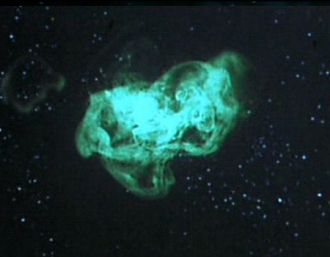
In Star Trek, Murasaki 312 or Murasaki Effect is a quasar-like electromagnetic phenomenon. In the episode "The Galileo Seven" of the original series, it ionized an entire sector of space, including four solar systems, and the USS Enterprise was under standing orders to investigate the formation. The USS Enterprise-D conducted a long-range sensor scan of the Murasaki Quasar in the Star Trek: The Next Generation episode "Data's Day".
In real physics, a quasar (QUASi-stellAR radio source) is an extremely powerful and distant active galactic nucleus - a compact region surrounding the central supermassive black hole of a galaxy. A quasar consists of a black hole surrounded by super-heated gas that gives off prodigious amounts of radiation - sometimes a billion times the mass of our own Sun. Quasars begin life as distant galaxies, and eventually they collapse, and the galaxy and gas is swallowed by the black hole. They are also the most distant objects we have ever seen. More than 100,000 quasars are known and they are between 780 million and 28 billion light-years away. Because of the great distances to the furthest quasars and the finite velocity of light, we see them and their surrounding space as they existed in the very early universe. Although quasars appear faint when viewed from Earth, the fact that they are visible from so far away means that quasars are the most luminous objects in the known universe. The quasar that appears brightest in the sky is 3C 273 in the constellation of Virgo. It has an average apparent magnitude of 12.8 (bright enough to be seen through a small telescope), but it has an absolute magnitude of -26.7- about 2 trillion times that of our sun, or about 100 times that of the total light of average giant galaxies like our Milky Way.


The Murasaki Quasar